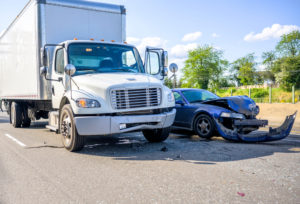
Amazon Truck Accidents – Is Amazon Liable for Delivery Truck Accidents? Amazon’s growth has been explosive in recent years, especially during the pandemic as more and more people relied on their renowned two-day shipping guarantee over risking venturing into physical stores.
We’ve seen more and more Amazon-branded and not branded delivery trucks, as the case may be, since Amazon launched an initiative to allow drivers to use their own vehicles (or the odd rented Uhaul). As a result, accidents of course have become more common. What differentiates Amazon cases from other trucking accidents, however, is the degree of control that the company exerts over its drivers, which may be key in determining liability in increasing cases of negligent business practices.
Respondeat Superior Theory and Liability Avoidance with Contractors
Respondeat Superior is a legal doctrine used in tort law that holds that an employer or principal is responsible for the wrongful acts of its employee or agent if those acts occur within the “scope of the employment.”
This doctrine would make Amazon liable for the actions of its delivery drivers if they are held as employees that are performing acts within the scope of their employment.
However, one exception to the Respondeat Superior doctrine is that it does not apply to independent contractors. This is an exception that large corporations understand, and they seek to use the label “independent contractor” wherever possible to dodge and shield themselves from liability (for example Uber, Lyft).
Independent Contractor exception
The independent contractor exception does not apply, when several factors are in place that shows a relationship between the parties more in the line of employer-employee, including among others: the high degree of control that the principal has over the agent; whether the agent is engaged in a distinct occupation apart from the tasks performed for the principal; the skill required to perform those tasks; whether the agent or principal supplies the tools required for the work; and whether the work is part of the principal’s regular business.
It doesn’t take a detailed legal analysis to come to the conclusion that, on the balance, the type of work that these delivery drivers are performing appears to fall more under the scope of regular employment, particularly as the job does not require specialized skill and the work is a major part of Amazon’s business.
Another factor that is generating a lot of attention is the sheer degree of control that Amazon attempts to exert on its “contractors” through the use of their Big Brother employment software. Similar to what warehouse employees are subjected to, the software for drivers tracks their every move, including “backup monitoring, speed, braking, acceleration, cornering, seatbelt usage, phone calls, texting, in-van cameras that use artificial intelligence to detect for yawning, and more.”
Man Left With Severe Brain and Spinal Injuries, After Collision with Amazon Delivery Truck
A motor vehicle accident left 24-year-old Ans Rana with catastrophic brain and spinal injuries when an Amazon delivery truck slammed into his brother’s Tesla Model S while he was in the back seat.
The car had stopped behind a stalled vehicle on Atlanta’s Interstate 75 when the truck plowed into them traveling over sixty miles an hour in a fifty-five-mile zone. Prior to the crash, Rana had wanted to follow his older brother, a doctor, into the medical field. Tragically after the accident, he has lost the use of both of his legs, arms and requires full-time care and rehabilitation.
“Behind the Rabbit”
According to Rana’s lawsuit, he blames the e-commerce giant due to a number of the above-mentioned factors that take Amazon out of the realm of contractor-contractee and into employer-employee status. Along with the high degree of control that the company exerts on its drivers, there is also immense pressure to make deliveries within the prescribed timeline – if a driver falls behind, Amazon employees send texts that a driver is “‘behind the rabbit’ and needs to be ‘rescued’ to ensure that all the packages on Amazon’s route are delivered in compliance with Amazon’s unrealistic and dangerous speed expectations.”
Amazon, of course, disputes liability with the argument that the driver was a contractor in the employ of Harper Logistics, LLC, a “last mile delivery service” and one of many small businesses which have been created in recent years to cater exclusively to the Amazon delivery economy.
Amazon launched the initiative to help start these companies as “delivery service partners” in 2018, with the promise to help secure better deals on insurance, hiring ads, and leases for its delivery trucks. The eCommerce giant was heavily involved in the creation of several thousand of these driver businesses that it distinguishes as “contractors” and not employees.
Amazon Algorithms and Software
Rana’s attorney, Scott Harrison, argues that the algorithms and software that Amazon uses to monitor its drivers is evidence of the control that Amazon exerts over its so-called “contractors:” everything from the number of packages drivers are required to deliver to whether the drivers should be fired.
The theory that Harrison is pursuing requires greater access to the workings of Amazon’s software and algorithms in order to prove its case – something that Amazon is vehemently fighting against under the guise of trade secrets. The potential scrutiny that this case could bring down on the company is concerning considering the long line of bad press spotlighting its poor treatment of workers as “robots” subjected to the whims of its dystopian algorithms. Rana’s case joins over a hundred others naming Amazon Logistics as a defendant in 35 states in 2021 alone – more than four times the volume of cases filed in the year prior.
Amazon Puts Profits Over People – Suggests Hiring Drug Offenders Over Raising Hourly Wage
Many Amazon drivers have answered this question: they are at the mercy of an inflexible automated system that puts quantity over driver safety and punishes them for infractions, even in cases where they claim they did nothing wrong.
This includes if the driver was found to be too slow according to Amazon’s monitoring software. The common refrain both at warehouses and on the road is that Amazon’s expectations are unreasonable; even Amazon itself acknowledges that about one in ten trips a driver fails to deliver the prescribed number of packages – typically two hundred and fifty per ten-hour shift.
Amazon’s employee turnover is extremely high as a result – and there is evidence that in their rush to hire bodies to do the job the company is engaging in negligent hiring practices. For example, the driver in Rana’s case had disclosed a history of drug abuse with the company but he was accepted for the delivery role regardless. Amazon has also reportedly told their driving contractors to stop screening applicants for marijuana use to widen the talent pool without raising their hourly wage.
Injured in a Truck accident?
Personal injury lawyers across the country are realizing the dangers that these business practices create and are stepping up to hold Amazon and other negligent parties accountable. If you or a loved one have been harmed in a trucking accident, contact Dr. Shezad Malik Law Firm today at 214-390-3189 to get started on the path to justice.

Shezad Malik is an Internal Medicine and Cardiology specialist, a Texas Medical Doctor (retired) and Defective Medical Device and Dangerous Drug Attorney. Dr. Shezad Malik Law Firm has offices based in Fort Worth and Dallas and represents people who have suffered catastrophic and serious personal injuries including wrongful death, caused by the negligence or recklessness of others.











Comments for this article are closed.